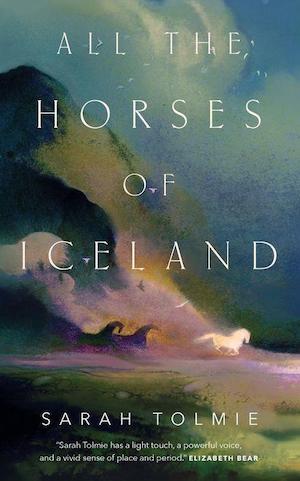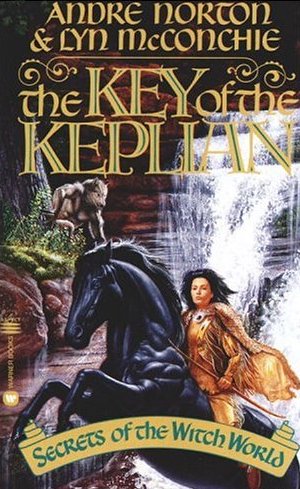I see why this one of Andre Norton’s numerous collaborative novels is so dear to so many. It’s just about pure fan-service, and reads as if written by a devoted fan. It revisits one of her all-time favorite worlds, the Witch World, and uses one of her favorite narrative devices, the Earth person passing through a portal into an alien universe. That Earth person is Native American, which was Norton’s favorite non-generic-white-American ethnicity. There’s war and wandering and horrible monsters and subterranean adventures and ancient ruins with their equally ancient and still functioning inhabitants and, of course, the great battle between Light and Dark.
And, which is particularly relevant to my interests, there are animal companions. Wonderful ones. Better yet, they’re creatures who in Norton’s solo novels are completely of the Dark, the terrible and beautiful horselike Keplians. Here however, we’re shown that Keplians weren’t originally designed to be evil. We learn their real history and their real purpose.
I have a considerable soft spot for works that rehabilitate incorrigible bad guys. Make them horses, at least in form, and I’m pretty well sold.
I did have to make a few accommodations in order to get through the book without a writer/editor/copyeditor meltdown. The craft is journeyman level with occasional flares of almost-mastery. There are tics and slips that minus the Keplians would have bounced me straight out.
McConchie cannot pace a story. Her timeline stretches interminably, dragging out through months and years, except in places where it jumps through whole chunks of plot and character in a handful of disorganized sentences. Events and revelations take an artificially long time to happen, mostly in order to overcome problems with basic plotting: Earth person needs to learn languages and history of Witch World, Keplian foals need to grow up enough to be ridden. Poor Romar spends years in durance vile while Eleeri putters around and rambles and noodles takes her sweet time making up her mind to, like, you know. Rescue him.
It doesn’t help that there is some awareness of this, whether on her part or on the part of an editor who might have had questions. The result is frequently a rumination—often in the middle of a desperate action scene—on all the ramifications of whatever is happening, topping off with a shrug or a giggle or a chuckle and “No point in worrying about it now,” or worse, “Oh, well, it doesn’t matter anyway.” Somewhat less frequently but not seldom, the character may even pull themself up short, or be pulled up short, and reminded that, hello, desperate straits here, stop thinking and start acting.
Buy the Book


All the Horses of Iceland
What saves it for me is that, for all her weaknesses of craft and skill, McConchie put her heart and soul into the Keplians. Her writing reaches its greatest heights when she focuses on them. She may ramble off on tangents or repeat herself in multiple scenes, but she loves these creatures, and she wants us to love them, too.
I see Norton’s influence in the alienness of their minds, as well as in Eleeri’s ability to look deep into them without recoiling in horror. Norton did not herself do much with redemption for beings of the Dark, but I can see her approving of the way McConchie transformed the nature and the destiny of the Keplians. The way it happens, and the bond they form with humans, owes more than a little to the works of Lackey and McCaffrey, but its roots are solid Norton: the telepathic connection, the strong collaboration against terrible enemies. The amulet Eleeri carries, the sapphire-eyed Keplian that transforms at need into a live stallion, echoes the likes of the Crystal Gryphon and the Jargoon Pard.
The social lives of Keplians are written from a place of knowledge about horses. The killer rapist stallions reflect all too many horse people’s view of horse stallions, and the terribly abused mares and the endangered foals come from the same harrowing place. They’re an exaggeration of the worst of Earth horsekeeping. That’s the work of the Dark, we’re shown. The Light is far gentler, with far more choice and volition for the mares, and safety and love for the foals, which shifts them away from the Dark and into the Light.
The one thing that I would wish is that McConchie had given actual horses more of the love she gave the Keplians. As with the first Dragonriders in McCaffrey, once the fancy shiny new alien creatures come on the scene, horses get short shrift. Eleeri, to be fair, appreciates the pony she rides through anything and everything, and he’s presented as loyal and hardworking and brave, but there’s no actual mental bond with him and he’s not very intelligent. He’s just an animal, as opposed to the Keplians, who are glorious superior beings.
As a dedicated horse person, I beg to differ. My mares are just as imperious as Keplian mares and queen dragons, and my stallions have been just as lovely as Hylan is raised to be. There is nothing dull or slow-witted about horses, even if they don’t have sapphire eyes or silver hooves or dragon scales.
So there.
Still. I’m glad I read this last of this long Reread. It represents one of the truly wonderful things about Andre Norton: her great generosity in sharing her worlds and characters. She loved and appreciated all her fans, and she served as mentor and guide to many younger writers.
The Key of the Keplian at its heart is fan fiction, and that’s how, in the end, I opted to read it. Fanfic can be beautifully and skillfully written, but that’s not what it’s really about. It exists to pay homage to the original, to build on it, to add the writer’s own vision to the existing text. Much of what’s written here is pastiche of Norton scenes and situations and characters, strung together into a narrative that gives us a new insight into Keplians and revisits a favorite theme, the adept held in prison by the Dark and rescued by their one true love.
As a novel it’s lacking a good bit of craft. As fic it works, and is beloved, because it captures the heart of its subject. We’re not here for the deft plotting or the brisk pacing. We want, and get, our feisty orphan of Native American heritage, our scions of the Old Race after the Turning of the Witch World, our kickass animal companions. We get to revisit a favorite world, engage in a familiar battle with a satisfying conclusion, and know that this is good; Norton herself gave it her blessing.
I’ll be back one last time with a summing up of the Reread. I hope you’ll join me in talking about your favorites (and not so favorites), and share your thoughts about Norton’s writing and her legacy.
One last time then, next time.
Judith Tarr has written historicals and historical fantasies and epic fantasies and space operas, many of which have been published as ebooks. She has won the Crawford Award, and been a finalist for the World Fantasy Award and the Locus Award. She lives in Arizona with an assortment of cats, a blue-eyed dog, and a herd of Lipizzan horses.










